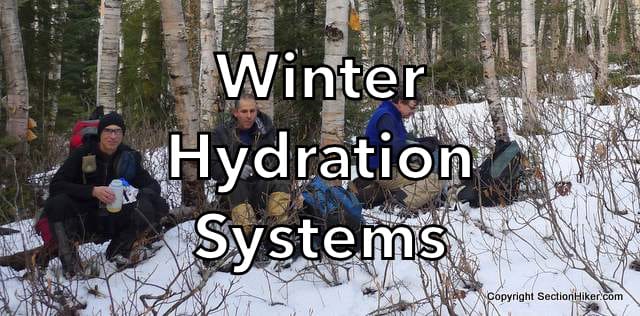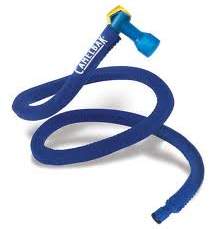
While there will always be a heated debate about what the best water bottles or hydration system required for winter hiking is, I think we’d all agree that the minimum requirements for winter use are as follows:
- The water you bring on a hike can’t freeze
- The warmer the water stays the better because drinking cold water in cold weather can chill you
- The bottle cap, hose, or mouthpiece shouldn’t freeze in place and prevent you from drinking your water
- Your water container should be able to withstand hot liquids
While there are many different winter systems that satisfy these conditions, each of them has pros and cons that are worth looking at to help you decide what’s right for you and the climate where you plan to hike.
Hydration Reservoirs and Drinking Tubes
I know many people who use hose-based hydration systems for 3 season hiking and prefer to use them in winter because they lower the barrier to staying hydrated in the drier winter air. If you intend to use a system like this, it’s best to purchase one with an integrated insulation sleeve like the Camelbak Insulated Unbottle that you can switch between different backpacks depending on the amount of gear and insulation you need to carry during the day. While Camelbak and other manufacturers sell snowsport specific skiing backpacks with integrated hydration systems, these are often not large enough to carry enough winter clothing or gear on longer hikes.

In addition to reservoir insulation, you’ll probably want to add drinking tube insulation to your hydration system to keep the hose and mouthpiece from freezing. While these can be a bit tricky to slide onto a drinking tube, they tend to be interchangeable between brands so you can mix and match components to suit your preferences.
The theory is that the body heat that radiates from your back will keep your hydration reservoir from freezing in winter. You can augment this by filling your reservoir with boiling hot water, surrounding it with insulating clothing inside your backpack, or even stuffing a Grabber handwarmer into your pack’s hydration pocket to heat it while you are hiking.
In addition, there is a technique commonly used to keep you drinking hose and mouthpiece from freezing. After taking a sip of water, blow into your drinking hose to push any remaining water in the hose back into the hydration reservoir so it doesn’t freeze in place. This takes some practice to become automatic, but it really does help to keep the hose clear, even if it is wrapped using drinking tube insulation.
If there’s a downside to using a hydration reservoir it that they are difficult to refill with boiling snowmelt on overnight trips without burning your hands or getting your gloves soaked. But provided you are not hiking in very cold temperatures or taking extremely long day hikes, a hydration system can be adapted successfully for cold weather use.

Nalgene Bottles
Wide-mouth Nalgene Bottles (32 ounce size) are also a very popular choice for carrying water in winter, because they can safely hold hot liquids, they stand up by themselves, they’re easy to refill and clean, easy to drink from, and most hikers have a few sitting around the house already.
Like hydration reservoirs, it’s best to augment them with an insulation sleeve to help keep their contents hot throughout the day particularly if you hang one from your hip belt while you are hiking. If you carry multiple Nalgenes, it’s easiest to cover all of them with an insulation sleeve, but you can also store them in your pack smothered in an insulation layer like a down coat and they will stay warm all day. With all water bottles, it’s best to use wide mouth ones in winter so that ice doesn’t form in their neck and to store them upside down to prevent the threads from freezing, even if they’re stored in an insulation sleeve.
If there’s a downside to Nalgene bottles it’s that you often need to take your gloves or mittens off to open them which can be clumsy due to the lid keeper strap. This can be very uncomfortable or downright dangerous if you are in a very cold or windy place, like on a mountain. It is also possible to crack Nalgenes made out of hard plastic, so you should use the Nalgene bottles made out of high density polyethylene, if possible. They’re a lot less expensive too.

Hunersdorf Bottles
Personally, my favorite winter water bottle is called a Hunersdorf Bottle, which is similar to a Nalgene but does not have a keeper strap connecting the bottle and the cap. These bottles are often recommended by mountaineering guides for expeditions because they can be opened without taking your gloves or mittens off in cold weather. Like Nalgene Bottles, they can safely hold boiling hot liquids, they’re easy to clean, easy to drink out of and stand on their own.
I’ve been using Hunersdorf Bottles for going on 8 years and I like them because they have all the benefits of a wide mouth polyethylene Nalgene, but weigh several ounces less.
Forty Below makes an insulation liner for Hunerdorf Bottles, which’s also compatible with 32 oz Nalgenes and can also be opened while wearing mittens since it’s closed using a velcro tab instead of a zipper. This is very handy when you need a drink but really need to keep your mittens on, no matter what, to prevent frostbite. You’d be surprised how quickly your fingers can freeze if they get the slightest bit wet in freezing weather.
Metal Bottles
Most popular metal bottles (Hydroflask, etc) are a bad choice for winter hiking because the caps freeze closed or the contents freeze. The same holds for insulated metal bottles or thermoses because they’re just too heavy to carry. For example, a 32 oz insulated Insulated 32 oz Hydroflask bottles weigh close to 15.5 oz, while a Hunersdorf Bottle weighs 4.8 oz. That difference adds up when you have to carry three liters of water on a winter hike.
SectionHiker is reader-supported. We only make money if you purchase a product through our affiliate links. Help us continue to test and write unsponsored and independent gear reviews, beginner FAQs, and free hiking guides. SectionHiker.com Backpacking Gear Reviews and FAQs
SectionHiker.com Backpacking Gear Reviews and FAQs
Great article Philip.
+1 for the Hunnersdorf bottles. Bought mine from 40 below many years ago and still use it to this day on cold weather hikes.
I’ve generally used a wide mouthed Nalgene while winter camping, and can’t quite see the benefits of the Hunnersdorf. The Nalgene weighs 1.3 oz less (3.5 oz to 4.8 oz from the links you posted). I removed the annoying lid keeper years ago, and the caps have plenty of grip to open with even the beefiest gloves.
I had the valve freeze up on my Platypus just this weekend when the temp was only down 30 degrees. Took a half hour of being tucked inside my shirt to thaw it out. It’s pretty easy to mess up and be stuck with an inaccessible water source. I actually like a Hydroflask as a reserve kept inside my pack on cold day hikes or with a hot drink for lunch. Sometimes the liquid is borderline too hot to drink at lunch.
I just pack a Hunersdorf bottle of Bengal Spice tea in my backpack and stuff it down amoungst my insulating layers, where it will stay hot all day. I also pack a Swiss Cheese sandwich on top, which melts into the bread (from the heat of the bottle), so I can enjoy a hot lunch and hot tea at the summit. Weighs a lot less than carrying an insulated bottle and has a great side effect.
yummmm!
Any experiences on using compressable flasks like hydrapak softflask or OMM flexi flask in cold conditions?
Considering the weight of the bottle plus the one of the liner, an isulated bottle is still a bit heavier, but not that much. Zojirushi insulated bottles, for exemple, are ones of the lightest on the market. And for a one day hicking, where a few more oz aren’t a big deal, I really appreciate the insulation for my hot chocolate or soup.